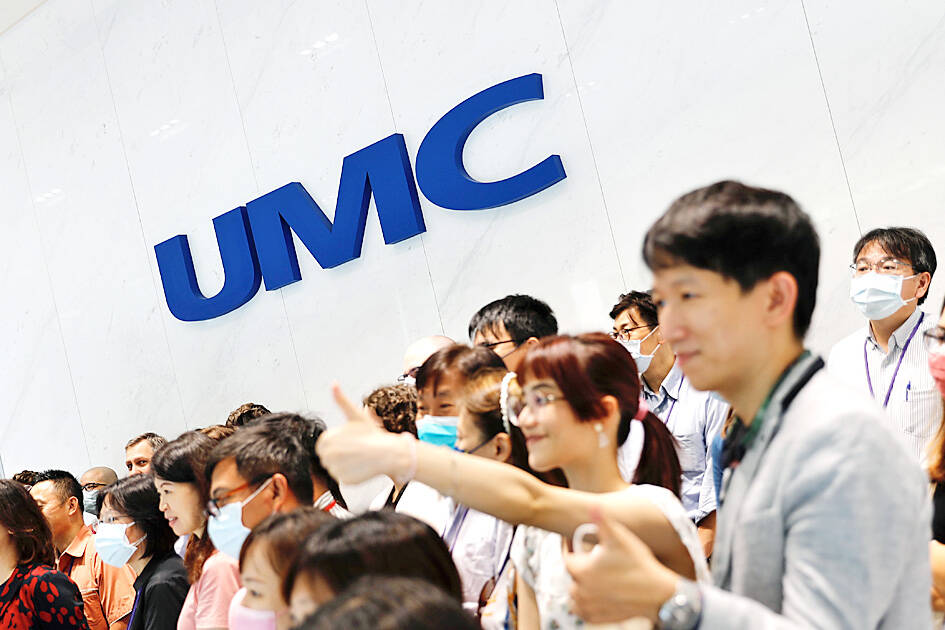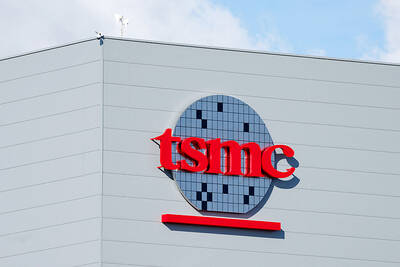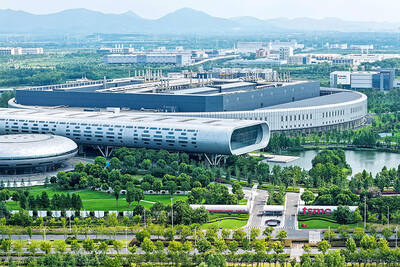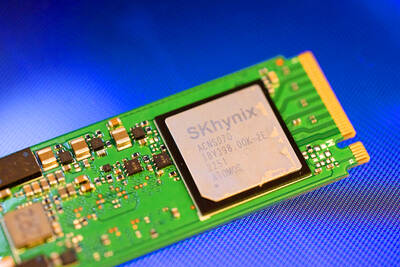United Microelectronics Corp (UMC, 聯電), the world’s No. 3 contract chipmaker, yesterday said its factory utilization would fall to the low 60 percent range this quarter as customers grapple with excess inventory, although early signs indicate that demand is stabilizing in the PC and smartphone segments.
UMC provided the business outlook after reporting a 1.4 percent sequential improvement in net profit last quarter to NT$15.97 billion (US$493.8 million), from NT$15.64 billion in the second quarter, while factory utilization stood at 67 percent, the lowest in about 12 years.
On an annual basis, net profit plunged about 41 percent from NT$26.99 billion, the company said.

Photo: Ritchie B. Tongo, EPA-EFE
“For the fourth quarter, with recent rush orders from PC and smartphone makers, we expect demand to gradually stabilize. However, customers are still maintaining a cautious and conservative approach in addressing inventory levels, while the conditions for the automotive business appears challenging,” UMC co-CEO Jason Wang (王石) told a virtual investors’ conference.
The automotive segment became the latest victim of an inventory correction cycle, Wang said, adding that UMC expects the inventory digestion to continue into next year.
That would lead to a decline in UMC’s auto chip business this quarter, but overall, auto chips would still make up about 15 percent of the company’s chip revenue this year, he said.
The PC and Chinese smartphone segments would remain stable compared with last quarter, he added.
Customers’ inventory digestion and stagnant end-product demand are expected to reduce UMC’s wafer shipments by 5 percent sequentially this quarter, the chipmaker said.
Average selling prices would be flat quarter-on-quarter, but with intensifying competition from Chinese rivals, the chipmaker said it might adjust prices downward for 8-inch wafers.
Gross margin is to fall to the low-30 percent range this quarter, from 35.9 percent last quarter, the company said.
However, UMC retained its capital expenditure for this year at US$3 billion and kept intact its Tainan’s P6 fab capacity expansion plan with 22-nanometer and 28-nanometer chip capacity designated for customers signing long-term supply agreements.
The chipmaker expects the P6 fab’s capacity to climb to 12,000 wafers per month by the end of this year and to rise further to 315,000 wafers per month by September next year.
In Singapore, a new clean room for its P3 fab is to be ready by the first half of next year as scheduled, the company said.
Last quarter, 22-nanometer and 28-nanometer chips together accounted for 32 percent of its total revenue, up from 29 percent in the second quarter.
To further differentiate its offerings, UMC is considering converting some of its 22-nanometer or 28-nanometer capacity into 12-nanometer fin field-effect transistor technology in response to customers’ demand for power-efficient chips, it said.
The firm also kept its artificial-intelligence (AI) packaging capacity expansion plans unchanged. It is to double its silicon interposer wafer capacity to 6,000 units by the first quarter of next year.
In addition to AI chip packaging capacity, UMC expects strong demand for related microcontroller units and chips with functionality such as sensing and connectivity, which is within its addressable market, it said.
“UMC is preparing those solutions for this market. That includes interposer solutions as well. We hope that with those solutions prepared we can enable our customers to capture market share in the AI application field. Many products we engage with today show there is a high possibility customers will start adding AI functions into end devices,” Wang said.

Taiwan Semiconductor Manufacturing Co (TSMC, 台積電) secured a record 70.2 percent share of the global foundry business in the second quarter, up from 67.6 percent the previous quarter, and continued widening its lead over second-placed Samsung Electronics Co, TrendForce Corp (集邦科技) said on Monday. TSMC posted US$30.24 billion in sales in the April-to-June period, up 18.5 percent from the previous quarter, driven by major smartphone customers entering their ramp-up cycle and robust demand for artificial intelligence chips, laptops and PCs, which boosted wafer shipments and average selling prices, TrendForce said in a report. Samsung’s sales also grew in the second quarter, up

On Tuesday, US President Donald Trump weighed in on a pressing national issue: The rebranding of a restaurant chain. Last week, Cracker Barrel, a Tennessee company whose nationwide locations lean heavily on a cozy, old-timey aesthetic — “rocking chairs on the porch, a warm fire in the hearth, peg games on the table” — announced it was updating its logo. Uncle Herschel, the man who once appeared next to the letters with a barrel, was gone. It sparked ire on the right, with Donald Trump Jr leading a charge against the rebranding: “WTF is wrong with Cracker Barrel?!” Later, Trump Sr weighed

LIMITED IMPACT: Investor confidence was likely sustained by its relatively small exposure to the Chinese market, as only less advanced chips are made in Nanjing Taiwan Semiconductor Manufacturing Co (TSMC, 台積電) saw its stock price close steady yesterday in a sign that the loss of the validated end user (VEU) status for its Nanjing, China, fab should have a mild impact on the world’s biggest contract chipmaker financially and technologically. Media reports about the waiver loss sent TSMC down 1.29 percent during the early trading session yesterday, but the stock soon regained strength and ended at NT$1,160, unchanged from Tuesday. Investors’ confidence in TSMC was likely built on its relatively small exposure to the Chinese market, as Chinese customers contributed about 9 percent to TSMC’s revenue last

LOOPHOLES: The move is to end a break that was aiding foreign producers without any similar benefit for US manufacturers, the US Department of Commerce said US President Donald Trump’s administration would make it harder for Samsung Electronics Co and SK Hynix Inc to ship critical equipment to their chipmaking operations in China, dealing a potential blow to the companies’ production in the world’s largest semiconductor market. The US Department of Commerce in a notice published on Friday said that it was revoking waivers for Samsung and SK Hynix to use US technologies in their Chinese operations. The companies had been operating in China under regulations that allow them to import chipmaking equipment without applying for a new license each time. The move would revise what is known